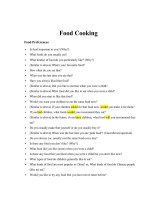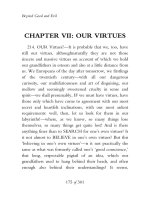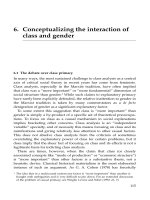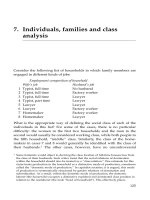tracking our class garden
Bạn đang xem bản rút gọn của tài liệu. Xem và tải ngay bản đầy đủ của tài liệu tại đây (28.2 MB, 14 trang )
Suggested levels for Guided Reading, DRA,
™
Lexile,
®
and Reading Recovery
™
are provided
in the Pearson Scott Foresman Leveling Guide.
Genre
Comprehension
Skills and Strategy
Realistic
fi ction
• Cause and Effect
• Literary Elements:
Theme
• Ask Questions
Scott Foresman Reading Street 4.3.1
ISBN 0-328-13444-9
ì<(sk$m)=bdeeeb< +^-Ä-U-Ä-U
Tracking Tracking Our Our
ClassClass GardenGarden
by Rena Korb
illustrated by Ginna Magee
13444_CVR.indd A-B13444_CVR.indd A-B 11/16/05 5:04:01 PM11/16/05 5:04:01 PM
Suggested levels for Guided Reading, DRA,
™
Lexile,
®
and Reading Recovery
™
are provided
in the Pearson Scott Foresman Leveling Guide.
Genre
Comprehension
Skills and Strategy
Realistic
fi ction
• Cause and Effect
• Literary Elements:
Theme
• Ask Questions
Scott Foresman Reading Street 4.3.1
ISBN 0-328-13444-9
ì<(sk$m)=bdeeeb< +^-Ä-U-Ä-U
Tracking Tracking Our Our
ClassClass GardenGarden
by Rena Korb
illustrated by Ginna Magee
13444_CVR.indd A-B13444_CVR.indd A-B 11/16/05 5:04:01 PM11/16/05 5:04:01 PM
1. Why did the students do research? What
happened as a result of their research? Write your
answers in a chart similar to the one below.
2. What questions did you have about gardening as
you read this book? How did this book help you
answer your questions? Where could you go to
find more information on gardening?
3. Reread page 17 and think about what the borers
did to the zucchini plants. What do you think the
word borer means?
4. How did Sandra change from the beginning of
the story to the end?
Reader Response
What happened?Why did it happen?
13444_CVR.indd C-D13444_CVR.indd C-D 11/16/05 5:04:10 PM11/16/05 5:04:10 PM
Tracking Our
Class Garden
by Rena Korb
illustrated by Ginna Magee
Editorial Offices: Glenview, Illinois • Parsippany, New Jersey • New York, New York
Sales Offices: Needham, Massachusetts • Duluth, Georgia • Glenview, Illinois
Coppell, Texas • Ontario, California • Mesa, Arizona
13444_001-024.indd Sec1:113444_001-024.indd Sec1:1 11/16/05 4:32:03 PM11/16/05 4:32:03 PM
Every effort has been made to secure permission and provide appropriate credit for
photographic material. The publisher deeply regrets any omission and pledges to
correct errors called to its attention in subsequent editions.
Unless otherwise acknowledged, all photographs are the property of Scott Foresman,
a division of Pearson Education.
Illustrations by Ginna Magee
ISBN: 0-328-13444-9
Copyright © Pearson Education, Inc.
All Rights Reserved. Printed in the United States of America. This publication is
protected by Copyright, and permission should be obtained from the publisher
prior to any prohibited reproduction, storage in a retrieval system, or transmission
in any form by any means, electronic, mechanical, photocopying, recording, or
likewise. For information regarding permission(s), write to: Permissions Department,
Scott Foresman, 1900 East Lake Avenue, Glenview, Illinois 60025.
2 3 4 5 6 7 8 9 10 V0G1 14 13 12 11 10 09 08 07 06 05
13444_001-024.indd Sec1:213444_001-024.indd Sec1:2 11/16/05 4:32:09 PM11/16/05 4:32:09 PM
3
Chapter 1 The New Garden
One warm afternoon in September, Ms.
Stinson surprised her fourth-grade class by
saying, “We’re going to hold class outside.
Follow me.”
All the students jumped out of their chairs and
formed a line. With the sun shining brightly, any
chance to go outside was a real treat.
As always, Cal rushed to be first in line.
Sandra, the new girl, stood by herself at the end.
Everyone else joined the line in groups of friends.
As they made their way from the classroom, they
talked quietly about what might be in store for
them outside.
13444_001-024.indd Sec1:313444_001-024.indd Sec1:3 11/16/05 4:32:09 PM11/16/05 4:32:09 PM
4
Ms. Stinson led the class outside. Melinda
looked concerned as she walked through the
grass because, after all, she was wearing her
new shoes. Darrell cracked jokes to anyone who
would listen. “Shh!” ordered Cal, frowning.
Sandra simply walked slowly at the back of the
line, keeping her eyes down.
Ms. Stinson brought the line to a halt. “Here
we are,” she said. She gestured to the ground
with her hands, and the students looked around
curiously. All they saw was a patch of dirt. “Meet
your future garden!” exclaimed Ms. Stinson.
The students murmured in confusion. There
were no vegetables, no flowers, not even any
plants. All they saw was dry, pale dirt with some
weeds and a bit of grass.
Melinda raised her hand and asked the
question on all their minds. “But where is the
garden?”
“We have to grow it,” said Ms. Stinson with a
broad smile.
The garden was going to be a special class
project. After they returned to the classroom,
Ms. Stinson divided the class into four groups to
research what to plant and how to care for the
garden.
13444_001-024.indd Sec1:413444_001-024.indd Sec1:4 11/16/05 4:32:17 PM11/16/05 4:32:17 PM
5
Cal instantly took charge by telling about
books and Web sites he knew of that they could
study. “Great, we’ve got another teacher,”
grumbled his group.
Darrell was excited to build a scarecrow with
his team of gardeners. “You’ve got to plant the
garden first,” Ms. Stinson reminded him.
Melinda had a warning for her group. “I don’t
like bugs or worms or getting my hands dirty.”
Sandra’s group hardly noticed her. She sat
quietly, with a book open on her lap. On a piece
of paper, she sketched creepy crawly bugs.
13444_001-024.indd Sec1:513444_001-024.indd Sec1:5 11/16/05 4:32:17 PM11/16/05 4:32:17 PM
6
The children spent an entire month
researching gardening. Finally, they were ready
for action, and on a crisp fall day they planted
their garden. Most everyone came dressed in old
jeans and T-shirts that they could get dirty. They
got down on their hands and knees in the dirt.
“Yuck!” cried Melinda when she got dirt on
her knee. “I’m going to mess up my clothes!”
13444_001-024.indd Sec1:613444_001-024.indd Sec1:6 11/16/05 4:32:21 PM11/16/05 4:32:21 PM
7
In the garden, Cal busily yanked up weeds.
Sandra seemed to be fascinated with a roly-poly
bug. Despite Darrell’s silliness—pretending to be
a cow eating grass—the class had soon cleared
the area. Ms. Stinson turned the dirt over with a
shovel while adding peat moss to make the soil
richer for plants to grow. The students used their
hands to smooth out the soil. Then they took a
step back and admired their work.
The next time the class visited the garden,
Sandra raised her hand. “What do we do now?
It’s starting to get cold, and we can’t plant
anything. I hope we didn’t do all this work in
vain!”
“We had to prepare the garden so it will be
ready for planting next spring,” explained Ms.
Stinson.
The class eyed the schoolyard. The trees
looked almost bare, a gray sky spread above their
heads, and the grass was turning brown. It hardly
seemed like a season to care about gardening.
Could Sandra be right?
13444_001-024.indd Sec1:713444_001-024.indd Sec1:7 11/16/05 4:32:28 PM11/16/05 4:32:28 PM
8
Chapter 2 The Garden in Winter
A few days later, Ms. Stinson gave her students
a new assignment. She challenged them to find
the answer to a question: What can you plant in
the fall? The students came back with exciting
results. Garlic! Chives! Freezing temperatures
and overnight frosts would not kill these bulbs as
they nestled underground.
“What about daffodils?” asked Melinda,
remembering her research. When Ms. Stinson
agreed, Melinda’s face lit up. Soon the class got
to work planting.
13444_001-024.indd Sec1:813444_001-024.indd Sec1:8 11/16/05 4:32:28 PM11/16/05 4:32:28 PM
9
Even in the cold, snow, and ice of winter, the
students visited the garden. Bundled up, they
gathered together to talk about the garden.
“What do you think our plants are doing right
now?” Ms. Stinson asked.
“They are sleeping through the winter so they
can be strong in the spring,” said Cal.
“Yes,” Darrell exclaimed. “They’re kind of like
bears that hibernate in the winter.”
“Well, I think they are cold down there in the
ground,” said Sandra. “Just like I am. This garden
isn’t any fun.”
“Oh, Sandra,” Melinda cried. “I know we
will have fun together in the spring picking the
beautiful daffodils!”
Sandra shrugged. It was hard coming to a
new school, but maybe she could find a friend in
Melinda.
13444_001-024.indd Sec1:913444_001-024.indd Sec1:9 11/16/05 4:32:32 PM11/16/05 4:32:32 PM
10
There wasn’t much to do in the garden during
the winter, so the class got ready for the coming
spring. Each group had to decide what to plant.
At first, Cal wanted to plant cucumbers, but
when he realized that everyone else in his group
wanted carrots, he agreed. Melinda’s group
decided to plant cherry tomatoes.
Sandra’s group decided on acorn and
butternut squash. “They won’t be ready until
next fall,” said Ms. Stinson.
“It’ll be just in time to decorate the
Thanksgiving table,” offered Sandra quietly.
She smiled when her whole group nodded and
smiled back at her.
Darrell’s group selected zucchini squash. “We
are going to try to grow a zucchini as big as a
baseball bat!” Darrell exclaimed.
13444_001-024.indd Sec1:1013444_001-024.indd Sec1:10 11/16/05 4:32:36 PM11/16/05 4:32:36 PM
11
Chapter 3 Spring Arrives!
Spring had almost arrived. The weather
turned warmer, and the class checked the garden
every day. Soon, the children could see that the
plants were growing!
The tips of the garlic and the onions they had
also decided to plant poked through the ground.
The green shoots of the chives stretched toward
the sky, and the daffodils grew thick, dark-green
stalks. On the day the daffodils bloomed into
frilly yellow flowers, Melinda and Sandra picked
a small bouquet for the classroom. Ms. Stinson
said it was finally time to plant the rest of the
garden.
13444_001-024.indd Sec1:1113444_001-024.indd Sec1:11 11/16/05 4:32:39 PM11/16/05 4:32:39 PM
12
On planting day the students, including
Melinda, came to school dressed in their old
jeans and T-shirts. Each group picked out a
planting spot in the garden.
Cal and his group dug several shallow holes
with their fingers. The carrot seeds were tiny,
no bigger than the heads of pins! The group
sprinkled in the seeds and then took turns
making sure all the seeds had enough space.
13444_001-024.indd Sec1:1213444_001-024.indd Sec1:12 11/16/05 4:32:43 PM11/16/05 4:32:43 PM
13
Unlike the carrot seeds, the zucchini seeds
needed to be bunched together without
touching. Darrell took charge because he really
wanted to grow a zucchini big enough to set a
world record.
The acorn and butternut squash group drew
circles in the soil as big as dinner plates. Everyone
gathered around and took turns poking one seed
into the ground at the center of each circle.
The tomato group did not plant seeds, since
Melinda’s grandmother’s gardening club had
donated some seedlings for them to use. They
placed the small tomato plants into holes they
had dug in the ground and gently piled up dirt
around the roots.
Then the children raced to fill up their
watering cans. They stood over the rows and let
the water sink deep into the ground.
13444_001-024.indd Sec1:1313444_001-024.indd Sec1:13 11/16/05 4:32:48 PM11/16/05 4:32:48 PM
14
After planting day, the students visited the
garden regularly. They kept the soil damp and
free of any weeds.
Each group had different problems to solve.
The tomatoes started to slump over, so the
students put wooden stakes into the ground and
tied up the plants with twine. The carrots were
growing too close together, and the students had
to thin out the rows by pulling some of the tiny
seedlings out of the ground.
And how all the plants grew! The green carrot
tops developed into lacy leaves, and the squash
plants began to spread along the ground. And
the students discovered that tiny green tomatoes
liked to hide underneath the plants’ leaves.
13444_001-024.indd Sec1:1413444_001-024.indd Sec1:14 11/16/05 4:32:49 PM11/16/05 4:32:49 PM
15
Chapter 4 Disaster Strikes!
But one day, Darrell noticed that the leaves
and stems of one of the zucchini plants were
wilting. The students gave the plant extra water
because they thought it was thirsty, but when
they went out to check the next day, the plant
didn’t seem any better. Then another zucchini
stalk started to wilt.
Ms. Stinson knelt down to inspect the sick
plants, and when she stood up, the class could
tell from the look on her face that it was serious.
“Some kind of bug is eating our plants. Let’s try
and figure out a way to make the bug go away.”
The students jumped quickly into their research.
13444_001-024.indd Sec1:1513444_001-024.indd Sec1:15 11/16/05 4:32:52 PM11/16/05 4:32:52 PM
16
“Garlic spray!” cried Darrell, as he jumped up
with the book still in his hand. He explained that
a mixture, including water, garlic, onion, and
red pepper, might be strong enough to keep the
bugs away.
After making the mixture, the students
poured it into spray bottles and squirted the
zucchini plants, but the bugs didn’t go away.
Cal thought maybe beetles were attacking the
plants, so the children took turns sitting next to
the young plants. When they found a bug, they
picked it off, and even Melinda took her turn.
13444_001-024.indd Sec1:1613444_001-024.indd Sec1:16 11/16/05 4:32:56 PM11/16/05 4:32:56 PM
17
No matter what the class did, however, the
zucchini plants didn’t get better. One day,
something terrible happened. One of the plants
died. So the class continued to hunt for answers.
Could insects be boring through the zucchini and
eating the plants from the inside? The children
examined the stems of the unhealthy plants and
found several small holes!
“We’re going to have to try to cut the borers
out,” said Ms. Stinson. She made a slit in the
stem, and inside sat a fat white caterpillar, which
she removed.
“Gross!” yelled Melinda.
Ms. Stinson repeated this process with the
other sick plants. Then she placed a mound of
dirt around the slit to keep the plant growing.
For the next few day the students eagerly
ran outside to check on their bug-free zucchini
plants, but to their surprise, a few of the plants
failed to perk up. Then another plant died.
“Well, class,” Ms. Stinson sighed, getting up
from her knees in the garden. “I’m afraid there’s
nothing more we can do for the zucchini plants.”
13444_001-024.indd Sec1:1713444_001-024.indd Sec1:17 11/16/05 4:32:59 PM11/16/05 4:32:59 PM
18
Then a small voice spoke up. “I’ve got an
idea,” said Sandra. Everyone turned to look at
her, eager to hear what she had to say.
“I got this idea from a book I was reading . . .”
Sandra’s voice trailed off.
“Please tell us more about it, Sandra,” said Ms.
Stinson. Melinda looked at Sandra and gave her
a smile of encouragement.
So Sandra told them about making reflectors
from aluminum foil. For some reason, the
reflectors often kept borers away from plants.
“Maybe they don’t like the sunlight shining off
the foil,” Sandra guessed.
13444_001-024.indd Sec1:1813444_001-024.indd Sec1:18 11/16/05 4:33:00 PM11/16/05 4:33:00 PM
19
Ms. Stinson asked Sandra to get materials
from the classroom to make the reflectors. When
Sandra came back, she demonstrated how to
make a reflector. She cut a square of foil and
poked a hole at its middle. Then she placed the
hole gently over one of the plants, slid the foil
down, and pressed it flat to the ground. The class
did the same to the rest of the zucchini plants.
For the next week, Ms. Stinson led the class
outside to check the garden. Each day was the
same—no more borers! Finally, Ms. Stinson made
an announcement. “I think all the bugs are
finally gone!”
The kids crowded around Sandra with cries of
“Good job!” and “You saved the zucchini!”
As they walked back to the classroom, Cal
hurried to catch up with Sandra. “That was so
neat,” he said. “Could you show me how you
figured that out?”
“Sure,” Sandra said with a big smile. “I’ll show
you the book, and you can even borrow it from
me if you’d like.”
13444_001-024.indd Sec1:1913444_001-024.indd Sec1:19 11/16/05 4:33:04 PM11/16/05 4:33:04 PM
20
Chapter 5 The Harvest
The class spent the rest of the spring taking
care of the garden. The week before school let
out for the summer, they had their first harvest.
All the students worked together to gather the
ripened crop.
Under the bright sun, the class picked t he
long stalks of the chives. To find the garlic and
onions, they looked for green stems sticking
straight up in the air. Then they wrapped their
hands around the stalks and pulled the bulbs
gently from the ground.
13444_001-024.indd Sec1:2013444_001-024.indd Sec1:20 11/16/05 4:33:05 PM11/16/05 4:33:05 PM
21
Melinda’s group led the search for the cherry
tomatoes. They picked only the tomatoes that
looked red all over, leaving the green ones on
the stems. To see if the carrots were ready, Cal
grabbed a carrot top sticking out of the ground.
When he pulled out a long orange carrot,
the class knew it would be a good harvest.
Darrell’s group had decided against growing
one big zucchini. “Smaller ones taste better,” he
explained.
Everyone did some snacking before they piled
up the crisp crop in a wheelbarrow and pushed it
to Ms. Stinson’s car. The vegetables would go to a
nearby food bank for people in need of food.
13444_001-024.indd Sec1:2113444_001-024.indd Sec1:21 11/16/05 4:33:09 PM11/16/05 4:33:09 PM
22
On the last day of school, the class carried out
its final task. The children planted a new crop of
vegetables. Most of the crop would ripen over
the summer.
“But who’s going to take care of our garden?”
Melinda asked.
“I’ll be here all summer long,” Ms. Stinson
told the class. “And you are welcome to help out
whenever you can.”
It turned out to be one of the hottest summers
on record! Still, the students, often with their
families, came out to work in the garden. They
didn’t care that the sun was blazing hot or that
sweat ran down their faces. They wanted to take
care of their prized plants.
In July the ground started to dry out, and it
seemed that no amount of water was enough
for the plants. Sandra, Darrell, Cal, and Melinda
got together and came up with an idea. They
covered the plant beds with dry grass clippings to
help keep in moisture.
As the summer went on, the plants grew larger
and stronger, and brightly colored vegetables
covered green stalks. In August, Ms. Stinson
invited the children and their families to a party.
After they all helped gather and wash the fresh
vegetables, everyone sat down to a garden picnic.
13444_001-024.indd Sec1:2213444_001-024.indd Sec1:22 11/16/05 4:33:13 PM11/16/05 4:33:13 PM
23
That fall the fourth graders returned as fifth
graders. They knew another class would take
over their garden, but Ms. Stinson had one more
surprise for them. She asked them to join her
new fourth-grade class to harvest the final crop
of the year: the acorn and butternut squash.
As they worked, the older students gave the
younger students helpful tips. The fifth graders
remembered when Ms. Stinson first introduced
them to the garden—a big patch of messy dirt.
Now it was a rich garden that had produced
good food, hard work, and new friends, and it
had been an amazing year of gardening fun.
13444_001-024.indd Sec1:2313444_001-024.indd Sec1:23 11/16/05 4:33:14 PM11/16/05 4:33:14 PM
24
An egg carton filled with potting soil makes a
nice place to plant seeds and grow them indoors.
A variety of seeds can be planted. The different
seeds can be identified by sticking a flat wooden
stick with the plant’s name on it at the edge of
each egg cup.
The seeds need to be planted just underneath
the surface of the soil in each egg cup so that
they can sprout. As you know, plants need water
to grow. An old, clean spray bottle filled with
water is great for watering plants. The fine mist
of the spray will keep the soil moist, and the
plants will grow best in a warm spot.
Eventually, tiny green shoots will pop out
of the soil, and the plants will need water and
sunlight. Soon the tiny green shoots will grow
into stalks with two leaves. At this point, the
plants will need more room to grow. A larger
pot, careful handling, and soil around the roots
will help the plants stay healthy.
Indoor Gardening
13444_001-024.indd Sec1:2413444_001-024.indd Sec1:24 11/16/05 4:33:19 PM11/16/05 4:33:19 PM
1. Why did the students do research? What
happened as a result of their research? Write your
answers in a chart similar to the one below.
2. What questions did you have about gardening as
you read this book? How did this book help you
answer your questions? Where could you go to
find more information on gardening?
3. Reread page 17 and think about what the borers
did to the zucchini plants. What do you think the
word borer means?
4. How did Sandra change from the beginning of
the story to the end?
Reader Response
What happened?Why did it happen?
13444_CVR.indd C-D13444_CVR.indd C-D 11/16/05 5:04:10 PM11/16/05 5:04:10 PM









